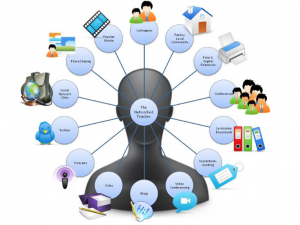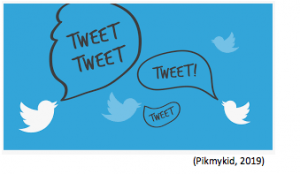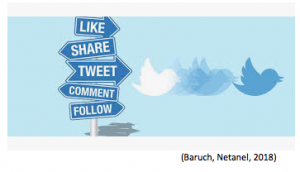(Teachers Using Tech, n.d.)
Last week we explored fostering reading cultures in our LLC programs. My focus was on using social media to promote reading and create active engagement with the library program. It is ironic, because one of my person professional goals is to expand in this area as well. I have maintained a social media presence starting in 2006 with Myspace, which I haven’t used in over 12 years. Currently I use: Facebook, Instagram, Twitter, LinkedIn, Pinterest, Snap Chat and TikTok. The latter social media, less so. My social media for the most part is personal and fairly locked down. I use it to connect with friends and share family pictures etc. This not something that I would feel comfortable opening up outside of my friendship group.

(Socialnomics, 2018)
The library program has shown me how social media can help with connecting educators and professionals but also how it can be used as a tool for sharing resources and engaging in learning experiences. I chose to set up a professional twitter account for this purpose, in part for coursework, but am seeing now the professional value. This twitter account is free from my child’s photos and doesn’t include personal commentary on politics or controversial subjects.
I have a professional social media account, but now what?
Friedman’s article, “Using Social Media for Teacher Professional Development”, breaks down the various social media platforms and how they can be optimized. He mentions that Twitter offers “a way to participate in education-focused conversations and idea sharing with other educators” (Friedman, 2020). Pinterest and Instagram, due to their image base, work best for sharing pictures, visual charts and worksheets. Whereas LinkedIn, is great for sharing educated related articles. Facebook blends all of the above (Friedman, 2020).
I am choosing to focus on creating/expanding my PLN and for that, I plan to use Twitter as my primary social media platform. I am not opposed to using other social media platforms, but in all honesty, when I think about maintaining my personal social media accounts and LLC social media accounts, I know that I need to prioritize one social media account for my professional development until I get the swing of a PLN.
The chapter, “Professional Development in Social Media” in Rhoads and Stachowiak’s book, tips on how to maximize Twitter potential as a tool for professional development is explored. It is suggested to:
- Follow, follow, follow
- Use Hashtags. This helps to organize topics and “topics can lead to communities and communities can lead to people!” (Rhoads and Stachowiak, 2017).
- Keep tweets short. Even though character counts have increased to 280, it is still best to stay concise and aim for much under that.
- Be cognizant of audience. “Protect your personal and professional connections by double checking what you tweet and what you re-tweet” (Rhoads and Stachowiak, 2017).
Katie Davis further recommends some tips for using Twitter and developing a PLN:
-
- Getting a “professional-ish” handle
- Make profile public
- Use current photo for profile pic and include a bio
- Manage tweets: create lists of accounts, use a Twitter client like TweetDeck or push tweets with something like Buffer
- Never retweet without reading
- Give credit. (Davis, 2018)
I found the ideas above helpful and they do challenge me. The take away from my readings is that building a PLN through social media requires dedicated commitment. And as cliche as it might sound – the more you put in, the more you get out. The management of the account is what I find the most daunting. Davis mentions she had professional and private accounts and this is not something she’d recommend as it was too difficult to manage. Whilst I believe she’s likely right, I still hope to maintain division between professional and private space. I like her list that she created in Twitter of her “Must follow library types” (Davis, 2018). I didn’t know how to do this before and can see its value when building a PLN. I haven’t used a Twitter client to streamline feeds before but I am familiar with pushing/scheduling social media like Buffer, though I prefer Hootsuite as you are able to schedule up to 30 messages with the free account versus Buffer’s maximum of 10, unless you upgrade to a paid subscription.
Who to follow? Building your PLN
Now that I am ready to get started, I now need to build the list of who I follow. Both Davis’ and Cool Tools For School have list suggestions from what they have built. Cool Tool for School also recommends: Starting with “Twitter’s ‘Who To Follow’, ask your friends, and watch who other people are talking to and pick some to follow (Cool Tool For School, 2019). All articles mention that by following others, Twitter users should not to become consumed with who follows back. “People may not follow you back right away. If they have lots of followers, they may not even notice you started following them. To connect with someone, say hello! Thank them for sharing great information. Watch for a chance to help them out or offer an idea” (Cool Tool For School, 2019). Renwich emphasizes the need for active participation to generate meaningful learning and to be a part of a give and take communication forum. He says, “Twitter should be a participatory experience: The more active you are on the site, the more you get out of it. This includes sharing your thoughts, links and blog posts” (Renwich, 2015).
“Don’t focus on follower count… When you become more active, you will start seeing that your professional network is growing naturally and other educators are getting to know you. That’s what having a social media presence is all about!” (Friedman, 2020)
Works Cited:
Baruch, Netanel. 2018. “How to Get Followers on Twitter? Here’s the Ultimate Guide.” [Image]. Retrieved from https://commun.it/blog/how-to-get-followers-on-twitter/
Cool Tool For School. 2019. “Thing 4: Twitter, Facebook & Personal Learning Networks”. (n.d.). Retrieved from https://cooltoolsforschool.net/twitter-pln/
Davis, Kate. 2018. My top tips for using social media for professional networking and more. Retrieved from http://katedavis.info/2018/10/my-top-tips-for-using-social-media-for-professional-networking/
Equalman. 2018. Socialnomics [ video file ]. Retrieved from https://youtu.be/2IcpwISszbQ
Friedman, Jordan. 2020. “Using Social Media for Teacher Professional Development.” Retrieved from: https://www.hmhco.com/blog/using-social-media-for-teacher-professional-development
Pikmykid. 2019. “9 Twitter Accounts Every Educator Should Follow.” [Image]. Retrieved from https://www.pikmykid.com/9-twitter-accounts-every-educator-should-follow/
Renwick, Matt. 2015. How Twitter Can Power Your Professional Learning. Retrieved from https://edtechmagazine.com/k12/article/2015/07/how-twitter-can-power-your-professional-learning
Rhoads, M and Stachowiak, B. 2017. “Professional Development via Social Media”. Igniting Your Teaching with Educational Technology (1st Edition). CreateSpace Independent Publishing Platform. Retrieved from https://edd7032017f2.pressbooks.com/chapter/6/
Teachers Using Tech. n.d. “The Innovative Educator: Developing Your Personal Learning Network (PLN).” [Image]. Retrieved from http://teachersusingtech.weebly.com/personal-learning-networks.html




 Follow
Follow
Excellent post full of practical advice and useful tips and tricks focused on implementing twitter to develop a Personal Learning Network. I am very appreciative you’ve shared all these guides, tools, recommended accounts and use of lists with your readers as they are all very practical tips and very useful. Your own growth already in developing a PLN, organized, professional focus and seperated from your personal life will go a long way to enabling ongoing goals and implementation of new practices and pedagogy. Like a garden, twitter requires regular cultivating, weeding and renewal!
Hi Nicole!
Awesome post! I love the approach you took; starting a new social media account and providing the tips and tricks you’ve found to help begin building your PLN! I appreciate the post you included by Jordan Friedman. One of the topics I wanted to look into more was using social media in education and I love how the author breaks down the platforms with a brief description of what it is used for along with a direct quote of what others have done with the platform. I think your PLN is off to a great start, well done!
Hello Nicole,
I love the idea of using Twitter as a tool to build on a learn about having a PLN. I have a twitter account @hargrace48 that I use mostly professionally. I have very few personal contacts and the tweets that I follow are mostly educational, some admittedly political as well.
I am just learning about # hashtags, and labels etc. I have a long way to go here! Using Twitter to develop your PLN is brilliant since there are so many resources available and easily accessible. As you have mentioned, Twitter is good for connecting with other educators and professionals and engaging in learning experiences.
I have been inspired into accessing my twitter account and using it as a tool to assist me with my interest in integrating STEAM into our school. I can also connect with other librarians and access more digital technology resources. Thank you for the inspiration, and the information about anticipating “followers.” Unlike how we can sometimes be tempted to count our “likes” on Facebook lol